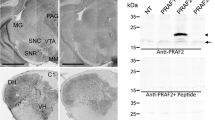Abstract
The distribution of the GABA transporter GAT-1 was studied by immunocytochemistry and electron microscopy in the monkey basal ganglia. Dense staining was observed in the globus pallidus externa and interna, intermediate in the subthalamic nucleus, and substantia nigra, and light staining in the caudate nucleus and putamen. Staining was observed in axon terminals, but not cell bodies. Electron microscopy showed that the GAT-1 positive axon terminals formed symmetrical synapses, suggesting that they were the terminals of GABAergic neurons. Comparison of areas high in GAT-1 protein with that of GABA showed a good correlation between the density in neuropil staining for GAT-1, and that of GABA.
Similar content being viewed by others
References
Albin, R. L., Young, A. B. & Penney, J. B. (1989) The functional anatomy of basal ganglia disorders. Trends in Neurosciences 12, 366–375.
Borden, L. A. (1996) GABA transporter heterogeneity: Pharmacology and cellular localization. Neurochemistry International 29, 335–356.
Delong, M. R. (1990) Primate models of movement disorders of basal ganglia origin. Trends in Neurosciences 13, 281–285.
Divac, I., Fonnum, F. & Storm-mathisen, J. (1977) High affinity uptake in terminals of corticostriatal axons. Nature 266, 377–378.
Graybiel, A. M. & Ragsdale, C. W. (1983) In Chemical Neuroanatomy (edited by EMSON, C. P.) pp. 427–504. Raven Press.
Guastella, J., Nelson, N., Nelson, H., Czyzyk, L., Keynan, S., Miedel, M. C., Davidson, N., Lester, H. A. & Kanner, B. I. (1990) Cloning and expression of a rat brain GABA transporter. Science 249, 1303–1306.
Kung, L., Force, M., Chute, D. J. & Roberts, R.C. (1998) Immunocytochemical localization of tyrosine hydroxylase in the human striatum: A postmortem ultrastructural study. Journal of Comparative Neurology 390, 52–62.
Liu, Q. R., Mandiyan, S., Nelson, H. & Nelson, N. (1992) A family of genes encoding neurotransmitter transporters. Proceedings of the National Academy of Science USA 89, 6639–6643.
Lu, X. R., Ong, W. Y., Mackie, K. A light and electron microscopic study of the CB1 cannabinoid receptor in the monkey basal forebrain. Journal of J. Neurocytology, submitted.
Mager, S., Neave, J., Quick, M., Labarca, C., Davidson, M. & Lester H. A. (1993) Steady states, charge movements, and rates for a cloned GABA transporter expressed in Xenopus oocytes. Neuron 10, 177–188.
Nakanishi, H., Kita, H. & Kitai, S. T. (1987) Intracellular study of rat substantia nigra pars reticulata neurons in an in vitro slice preparation: Electrical membrane properties and response characteristics to subthalamic stimulation. Brain Research 437, 45–55.
Nelson, H., Mandiyan, S. & Nelson, N. (1990) Cloning of the human brainGABAtransporter. FEBS Letter 269, 181–184.
Ong, W. Y., Yeo, T. T., Balcar, V. J. & Garey L. J. (1998) A light and electron microscopic study of GAT-1 positive cells in the cerebral cortex of man and monkey. Journal of Neurocytology 27, 719–730.
Radian, R., Bendahan, A. & Kanner, B. I. (1986) Purification and identification of the functional sodiumand chloride-coupled gamma-aminobutyric acid transport glycoprotein from rat brain. Journal of Biological Chemistry 261, 15437–15441.
Shink, E. & Smith, Y. (1995) Differential synaptic innervation of neurons in the internal and external segments of the globus pallidus by the GABA-and glutamatecontaining terminals in the squirrel monkey. Journal of Comparative Neurology 358, 119–141.
Smith, Y., Bevan, M. D., Shink, E. & Bolam, J. P. (1998) Microcircuitry of the direct and indirect pathways of the basal ganglia. Neuroscience 86, 353–387.
Smith, Y. & Parent, A. (1988) Neurons of the subthalamic nucleus in primates display glutamate but notGABA immunoreactivity. Brain Research 453, 353–356.
Smith, Y., Parent, A., Seguela, P. & Descarries, L. (1987) Distribution of GABA-immunoreactive neurons in the basal ganglia of the squirrel monkey (Saimiri sciureus). Journal of Comparative Neurology 259, 50–64.
Spencer, H. J. (1976) Antagonism of cortical excitation of striatal neurons by glutamic acid diethyl ester: Evidence for glutamic acid as an excitatory transmitter in the rat striatum. Brain Research 102, 91–101.
Yasumi, M., Sato, K., Shimada, S., Nishimura, M. & Tohyama, M. (1997) Regional distribution of GABA transporter 1 (GAT1) mRNA in the rat brain: Comparison with glutamic acid decarboxylase67 (GAD67) mRNA localization. Molecular Brain Research 44, 205–218.
Author information
Authors and Affiliations
Rights and permissions
About this article
Cite this article
Wang, X., Ong, W. A light and electron microscopic study of GAT-1 in the monkey basal ganglia. J Neurocytol 28, 1053–1061 (1999). https://doi.org/10.1023/A:1007056608820
Issue Date:
DOI: https://doi.org/10.1023/A:1007056608820



